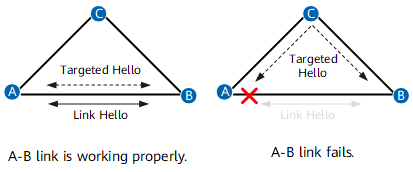LDP Session Protection
LDP session protection is an enhancement to the basic peer discovery mechanism. If the basic peer discovery mechanism fails, LDP session protection uses an extended peer discovery mechanism to maintain a session between LDP peers. After the basic peer discovery mechanism recovers, LDP can use it to rapidly converge routes and reestablish an LSP.
Background
If a direct link for a local LDP session fails, the LDP adjacency is torn down, and the session and labels are deleted. After the direct link recovers, the local LDP session is reestablished and distributes labels so that an LSP can be reestablished over the session. LSP establishment takes a period of time. During this process, traffic along the LDP LSP that is to be established is discarded.
To speed up LDP LSP convergence and minimize packet loss, the NetEngine 8000 F implements LDP session protection.
LDP session protection helps maintain an LDP session, eliminating the need to reestablish an LDP session or re-distribute labels.
Principles
In Figure 1, if the direct link between LSRA and LSRB fails, the adjacency established using Link Hello messages is torn down. Because the indirectly connected link is working properly, the remote adjacency established using Targeted Hello messages remains. Therefore, the LDP session is maintained by the remote adjacency, and the mapping between FECs and labels for the session also remains. After the direct link recovers, the local LDP session can rapidly restore LSP information. There is no need to reestablish the LDP session or re-distribute labels, which minimizes the time required for LDP session convergence.
Session Hold Time
In addition to LDP session protection, a session hold time can be configured. After a local adjacency established using Link Hello messages is torn down, a remote adjacency established using Targeted Hello messages continues to maintain an LDP session within the configured session hold time. If the local adjacency does not recover after the session hold time elapses, the remote adjacency is torn down, and the LDP session maintained using the remote adjacency is also torn down. If the session hold time is not specified, the remote adjacency permanently maintains the LDP session.
